Abstract
The behavior of magnetostructural transition and the magnetocaloric effect in the MnCoGe1.02−xGax (x = 0, 0.02, 0.04, 0.06) alloys are investigated in this study. The addition of Ga changes the crystal structure of MnCoGe1.02−xGax alloys at room temperature and reduces the phase transition temperatures with increasing Ga content. The coupling of magnetostructural transition and negligible magnetic hysteresis is observed in the Mn-Co-Ge-Ga alloy. At 305 K, under the action of a 5 T magnetic field, the MnCoGeGa0.02 alloy exhibits 23.47 J/kg∙K magnetic entropy change, and its refrigeration capacity reaches 387 J/kg. The large magnetic entropy change near room temperature and the high refrigeration capacity in the Mn-Co-Ge-Ga alloy make it a promising new type of refrigeration material.
1. Introduction
The magnetocaloric effect (MCE) is drawing great attention because of its potential application in magnetic refrigeration. Compared with traditional vapor compression cooling technology, magnetic refrigeration has been considered to be the most promising method due to the compactness, high efficiency and low environmental risk [1]. First-order magnetic transition produces remarkable changes in both crystal symmetry and magnetic structure, which leads to considerable MCE [2,3]. At the same time, the first-order magnetic transition materials will inevitably experience the magnetic hysteresis phenomenon when the high magneto-thermal effect is realized, which will reduce the refrigeration efficiency [4]. Therefore, it is very important to reduce the magnetic hysteresis loss of magnetic refrigerating materials in order to obtain a large MCE.
Mn-Co-Ge-based magnetic shape memory alloys have recently attracted much attention due to their large MCE and magnetic structure coupling [5,6,7,8,9,10,11]. It has been confirmed that the transition of the phase structure from the high-temperature hexagonal Ni2In structure to the orthorhombic TiNiSi structure occurs at the structural transition temperature of 650 K [5]. The second-order magnetic phase transition from paramagnetic to ferromagnetic occurs at the Curie temperature of 345 K, which is far lower than the structural transition temperature [6]. In the MnCoGe alloy, by reducing the phase transition temperature, the achievement of magnetostructural coupling can reach a better MCE and refrigeration effect [12,13,14]. In the past few decades, by adjusting the atomic percentage of Mn/Co or doping new elements to replace Mn or Co, a large magnetocaloric effect has been obtained [5,13,14]. In addition, adjusting the content of Ge can also reduce the phase transition temperature of the MnCoGe alloy [15]. At the same time, previous studies have confirmed that Mn1−xVxCoGe (x = 0.01, 0.02, 0.03) has a very small magnetic hysteresis loss in first-order phase transition, reaching 44 J/Kg, 53 J/Kg and 52 J/Kg, respectively, under the action of a 1.2 T magnetic field [16]. By replacing Mn with Ti, the magnetic entropy change reaches a good level when magnetic hysteresis loss is almost zero [17]. Previous studies have found that the magnetic entropy change of MnCoGe1.02 at 308 K under a 5 T magnetic field reaches 34 J kg−1 K−1 [5]. A huge magnetic entropy change is also achieved in MnCoGe with minimal Ga substitution [18,19]. Although the larger magnetocaloric effect can be obtained by adjusting the composition of Ge, its refrigeration capacity has not been improved. In this study, through the substitution of Ga for Ge in the MnCoGe1.02 alloy, the phase transition temperatures are decreased, and the coupling of magnetostructral transition and near-zero magnetic hysteresis is observed. A large magnetic entropy change and high refrigeration capacity is also achieved in MnCoGe1.02−xGax alloys.
2. Experimental Section
The nominal composition of the alloys was MnCoGe1.02−xGax (x = 0, 0.02, 0.04, 0.06). These alloys were prepared by arc melting under an argon atmosphere using high-purity elemental Mn, Co, Ge and Ga. The samples were homogenized at 1123 K for 5 days in vacuum quartz tubes, being furnace-cooled to room temperature. The crystal structures of the samples were studied by means of powder X-ray diffraction (XRD, LabX XRD-6100) using CuKα1 radiation (λα1 = 1.54056 Å). The martensitic transformation temperatures were investigated using a Perkin-Elmer diamond differential scanning calorimetry (DSC) instrument at a rate of 20 K/min. The magnetic properties of the alloys were examined by a Quantum Design PPMS-9 instrument under an applied field of up to 5 T.
3. Results and Discussion
Figure 1 shows the scanning electron micrographs of the MnCoGe1.02 alloy as a typical example. All of the samples were homogenized at 1123 K for 5 days and were furnace-cooled to room temperature. For small cooling rates, the MnCoGe1.02−xGax (x = 0, 0.02, 0.04, 0.06) alloys decomposed after furnace cooling, as shown in Figure 1. According to the results of EDS, the compositions of the MnCoGe1.02−xGax (x = 0, 0.02, 0.04, 0.06) alloys were consistent with the nominal composition.
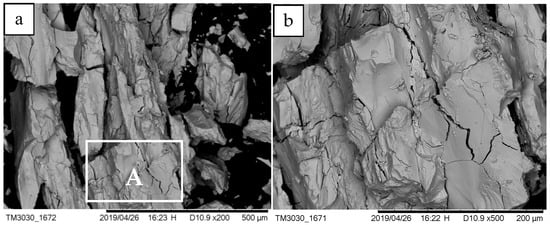
Figure 1.
(a) Scanning electron micrographs of MnCoGe1.02 alloy, (b) the magnification of region A in (a).
Figure 2 shows the XRD patterns of MnCoGe1.02−xGax (x = 0, 0.02, 0.04, 0.06) alloys at room temperature. It is evident from these data that the crystal structure changes from TiNiSi-type orthorhombic to Ni2In-type hexagonal structures with the substitution of Ga for Ge. Table 1 indicates the lattice constants and cell volumes of MnCoGe1.02−xGax (x = 0, 0.02, 0.04, 0.06) alloys. For the MnCoGe1.02 alloy, the coexistence of an orthorhombic martensite structure and hexagonal austenite structure appears, and the main diffraction peaks are indexed as the orthorhombic martensite phase. Though the coexistence of the martensite and austenite phase is still present in the MnCoGeGa0.02 alloy, the crystal structure is determined to be the hexagonal austenite phase by calibrating the three strong peaks, which implies that the structural transition occurs near room temperature. When x ≥ 0.04, it indicates that only Ni2In-type hexagonal structures are found for the two alloys.
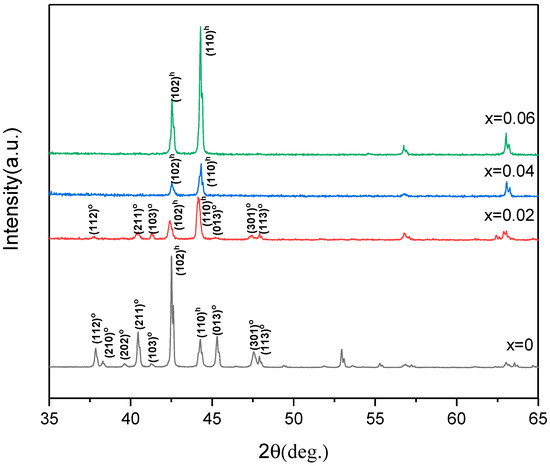
Figure 2.
XRD patterns of MnCoGe1.02−xGax (x = 0, 0.02, 0.04, 0.06) alloys at room temperature.

Table 1.
Lattice constants and cell volumes of MnCoGe1.02−xGax (x = 0, 0.02, 0.04, 0.06) alloys.
The XRD pattern in Figure 1 cannot exclude the presence of secondary phases since these have often a comparable structure to the targeted phase and the reflexes are overlapping. In order to determine whether the second phase exists, further investigation is underway.
Figure 3 displays the DSC curves of the MnCoGe1.02−xGax (x = 0, 0.02, 0.04, 0.06) alloys. The MnCoGe1.02−xGax (x = 0, 0.02, 0.04) alloys show a one-stage thermoelastic martensitic transformation due to only one endothermic and exothermic peak during the heating and cooling processes. For x = 0.06, there is no obvious endothermic peak or exothermic peak, and the phase transition temperatures of this alloy may exceed the initial temperature range, but its Curie temperature (as shown in the Figure 3d) is approximately 272 K. It can be clearly seen that the martensitic transformation temperatures decrease gradually with the Ga addition. For x = 0.02, the martensitic transformation starting temperature (Ms) is near room temperature, which is slightly lower than that of the MnCoGe1.02 alloy. When x = 0.04, the Ms is 246 K and it is 58 K lower than that of the MnCoGe1.02 alloy. Figure 4a shows the effect of Ga content on the martensitic transformation temperatures of MnCoGe1.02−xGax (x = 0, 0.02, 0.04) alloys (data from DSC curves). The martensitic transformation temperatures decrease notably with increasing Ga content, which is related to the valence electron concentration. As shown in Figure 4b, the martensitic transformation temperature decreases with the decrease in the valence electron concentration. Although the martensitic transformation temperature of MnCoGe0.96Ga0.06 is not obtained in the DSC curve, according to the change trend of valence electron concentration, it can be speculated that the martensitic transformation temperature of MnCoGe0.96Ga0.06 is lower than that of the MnCoGe0.98Ga0.04 alloy. Therefore, by adjusting the doping content of Ga, the martensitic transformation temperatures of the MnCoGe1.02−xGax alloy can be reduced.
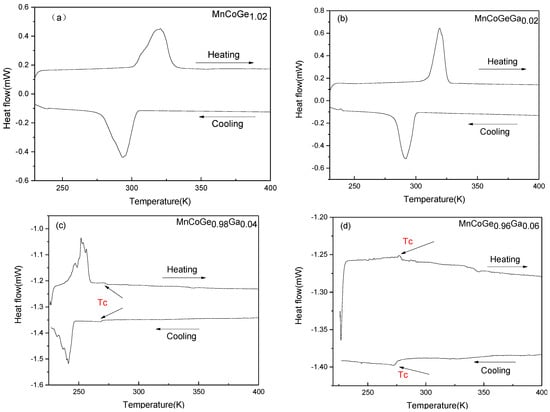
Figure 3.
DSC curves of the MnCoGe1.02−xGax (x = 0, 0.02, 0.04, 0.06) alloys. (a) x = 0; (b) x = 0.02; (c) x = 0.04; (d) x = 0.06.
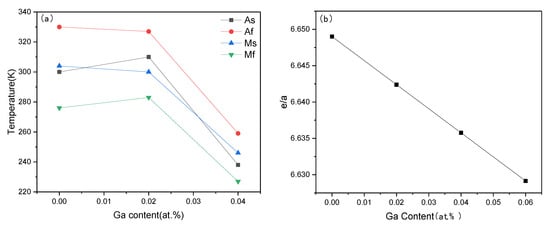
Figure 4.
(a) The effect of Ga content on martensitic transformation temperatures of MnCoGe1.02−xGax (x = 0, 0.02, 0.04) alloys; (b) The change of valence electron concentration with Ga content.
Figure 5 illustrates the M-T curves for MnCoGe1.02−xGax (x = 0, 0.02, 0.04, 0.06) at a 0.1 T magnetic field. For the samples with x = 0 and 0.02, obvious thermal hysteresis (∆Tthys) between heating and cooling processes is observed, implying the existence of the first-order structural transition. During the cooling process, the transition from paramagnetic hexagonal austenite to ferromagnetic orthorhombic martensite takes place. This behavior indicates that magnetostructural coupling appears for the two alloys. For the MnCoGeGa0.02 alloy, the martensitic transformation start temperature is 300 K, which is 2 K lower than that of the MnCoGe1.02 alloy. This is consistent with the DSC curve. When x = 0.04, in the cooling process, the martensitic transformation is followed by the Curie transition of hexagonal austenite (268 K). The martensitic transition start temperature is 21 K lower than the Curie temperature. This phenomenon suggests that magnetostructural coupling disappears. When the Ga content increases to 0.06, martensitic transformation is tuned to below the Curie temperature (272 K). The “step-like” transition of this alloy may result from two-step martensitic transformation. Whether the “step-like” transition is caused by the secondary phase needs to be further studied. The difference between the Curie temperature and phase transition temperature is up to 52 K, which is larger than that of x = 0.04. Because the Ga element has a larger atomic radius than that of the Ge element, replacing Ge with Ga may result in chemical pressure [15] due to volume expansion during the transformation from Ni2In to TiNiSi, which stabilizes the low-volume Ni2In phase and reduces the phase transition temperature. Based on the DSC and M-T results of the MnCoGe1.02−xGax alloys, only MnCoGe1.02 and MnCoGeGa0.02 alloys display magnetic structure coupling near room temperature. According to previous studies, MnCoGe1.02 experiences a significant magnetic hysteresis phenomenon [15]. At the same time, the doping of Ga can reduce magnetic hysteresis under a 2 T magnetic field. Therefore, low magnetic hysteresis and a good refrigeration effect may be obtained in the MnCoGeGa0.02 alloy.
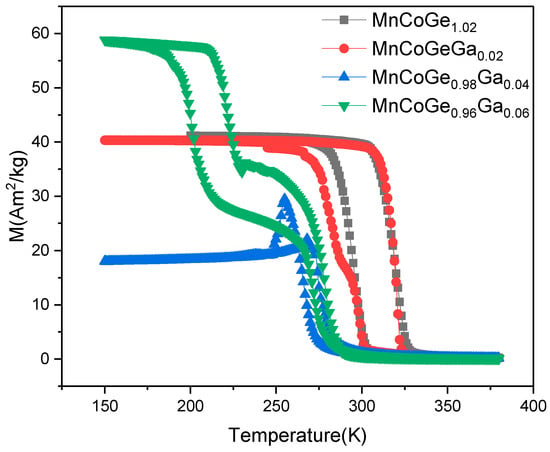
Figure 5.
M-T curves for MnCoGe1.02−xGax (x = 0, 0.02, 0.04, 0.06) at 0.1 T magnetic field.
The magnetization and temperature curves for the MnCoGeGa0.02 alloy in the fields of 0.1 T and 5 T are shown in Figure 6. Under a 5 T magnetic field, the curves illustrate similar phase transformation features compared to the MnCoGeGa0.02 alloy in the 0.1 T magnetic field. However, upon increasing the magnetic field to 5 T, the difference in magnetization between martensite and austenite significantly increases from 40 Am2/kg to approximately 105 Am2/kg; the Ms is decreased by around 7 K compared with that of this alloy under the 0.1 T magnetic field. This enhanced magnetization difference (ΔM) is beneficial to the magnetocaloric effects.
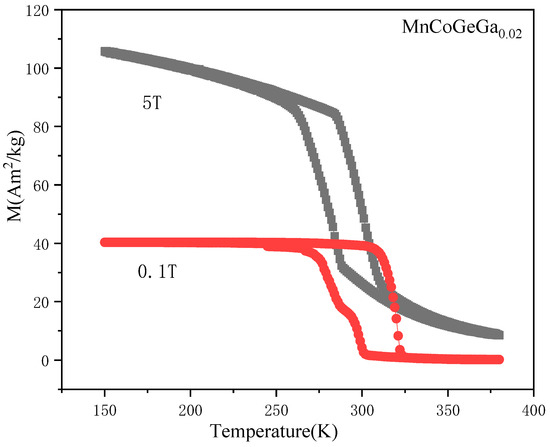
Figure 6.
M-T curves for MnCoGeGa0.02 alloy at 0.1 T and 5 T magnetic field.
The M-H curves for the MnCoGeGa0.02 alloy are shown in Figure 7a. The temperature range is 250–340 K and the temperature interval is 5 K. At each temperature, the magnetic field increases from 0 to 5 T, and subsequently decreases from 5 to 0 T. Figure 7a indicates that the M-H curves of the magnetizing and demagnetizing process almost coincide. From the enlarged view of the partial M(H) curves presented in Figure 7b, very small magnetic hysteresis is observed for this alloy between the magnetizing and demagnetizing curves, which is beneficial to improve the cooling efficiency in the magnetic refrigeration. When the temperature is higher than 305 K, its magnetization increases linearly with the increase in the magnetic field, and the magnetic saturation is not obtained in a field up to 5 T. This alloy exhibits a paramagnetic behavior in the austenite state. The M-H curves at 305 K and 300 K show a meta-magnetic behavior, which is due to the structural transformation from paramagnetic austenite to ferromagnetic martensite. As the temperate range is from 295 K to 250 K, typical characteristics of ferromagnetic materials are observed. This suggests that the samples are in a ferromagnetic martensite state. It should be noted from Figure 7 that such small magnetic hysteresis in the Mn-Co-Ge-Ga alloys is of great interest for magnetic refrigeration [16].
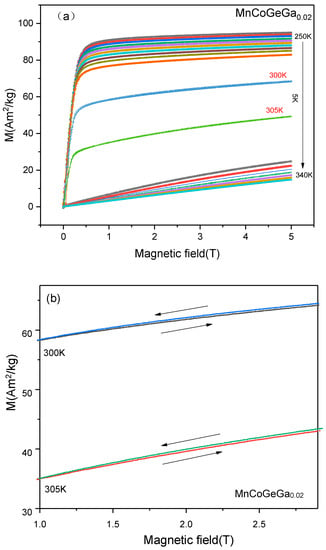
Figure 7.
Isothermal magnetization and field curves for MnCoGeGa0.02 alloy (a) and an enlarged view of the partial magnetization curves for MnCoGeGa0.02 (b).
Figure 8 exhibits the M2-µ0H/M curve (Arrott cure) of the MnCoGeGa0.02 alloy based on Figure 7a, where the temperature range is 250–340 K. According to some related reports [20,21], the presence of a negative slope or S shape in the Arrott curve verifies a first-order phase transition. As shown in Figure 8, the S-shaped curve is observed near structural transition, implying that the first-order magnetostructural transition occurs. This is consistent with the results of the M-T curve.
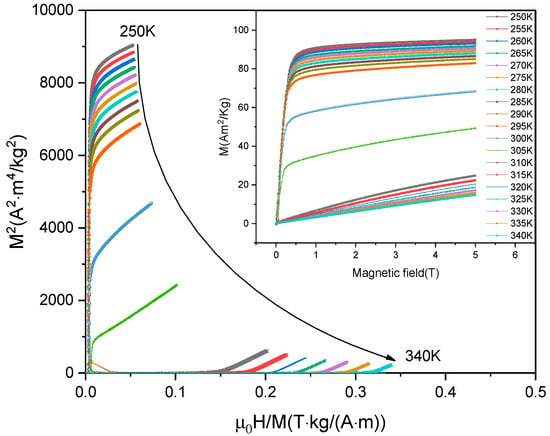
Figure 8.
Arrott curves of MnCoGeGa0.02 alloy.
Based on the above results, for the MnCoGeGa0.02 alloy, the coupling of magnetic transition and martensitic phase transition occurs near room temperature, and its magnetic hysteresis is very small. According to the study of Najam Ul Hassan [15], MnCoGe1.02 presents larger magnetic hysteresis. I. Dincer et al. studied the change in magnetic hysteresis loss in a 2 T magnetic field when Ga replaced Ge. The research shows that under the magnetic field of 2 T, the magnetic hysteresis loss of MnCoGe0.95Ga0.05 is close to zero, which is meaningful for magnetic refrigeration applications [19]. However, when the magnetic field is higher than 2 T, the magnetic hysteresis loss increases significantly, thus reducing the refrigeration capacity of MnCoGe0.95Ga0.05. Therefore, the MnCoGeGa0.02 alloy may have a better magnetocaloric effect.
The magnetic entropy change (ΔS) was numerically calculated from the magnetic isotherms using the Maxwell relation:
The magnetic entropy change as a function of temperature for the MnCoGeGa0.02 alloy is shown in Figure 9. The negative ΔS is attributed to the magnetic-field-induced ferromagnetic martensite to paramagnetic austenite transformation. When the magnetic field increases from 1 T to 5 T, the peak value of ΔS gradually increases. At 305 K, under the action of a 5 T magnetic field, the maximum absolute value of ΔS is up to 23.47 J/kg K. The refrigerating capacity (RC) is defined as:
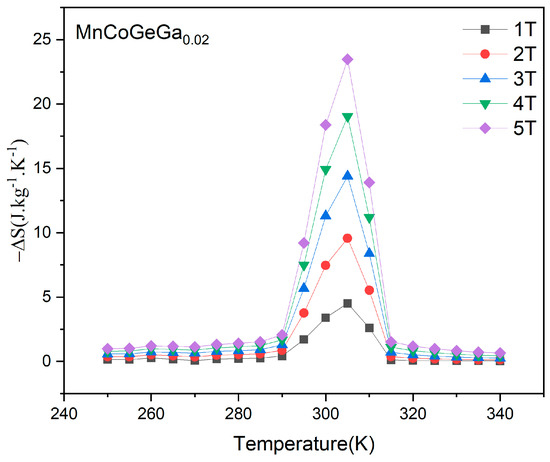
Figure 9.
Temperature dependence of magnetic entropy change of MnCoGeGa0.02 alloy.
In this relationship, Thot and Tcold are the lower and upper temperatures of the full width at half maximum of the ∆S-T curve, which indicates how much heat can be transferred from the cold end to the hot end of the refrigerator in one thermodynamic cycle. For the structure transition under a magnetic field of 5 T, the RC of the present sample evacuated in the vicinity of first-order transition is 387 J/kg.
Table 2 shows the maximum magnetic entropy change and refrigeration capacity under different magnetic fields for the MnCoGeGa0.02 alloy and some representative Mn-Co-Ge-based alloys [22,23]. Compared with other alloys, the MnCoGeGa0.02 alloy has a larger magnetic entropy, and its refrigeration capacity has been greatly improved. The enhanced ΔM and the near-zero magnetic hysteresis due to Ga substitution for Ge may be responsible for the larger magnetic entropy change and high RC. When the magnetic field is 5 T, the ΔM is up to 105 Am2/kg. The larger ΔM value may be related to the enhancement of the exchange interaction between Mn atoms with the addition of the Ga element. For the near-zero magnetic hysteresis of the MnCoGeGa0.02 alloy, a “thermal activation model” could be used to explain the phenomenon [24]. In this model, the generation of a phase transition potential barrier is related to various mechanisms, but the size of the potential barrier is reflected in the hysteresis amplitude. In comparison with the MnCoGe1.02 alloy, the magnitude of the phase change barrier in the MnCoGeGa0.02 alloy is changed by doping Ga; thus, the hysteresis was reduced to zero. Accordingly, the larger magnetic entropy change and high RC can be obtained in the Mn-Co-Ge-Ga alloy by the proper substitution of Ga for Ge.

Table 2.
The maximum value of magnetic entropy change and refrigerant capacity (RC) of different materials.
4. Conclusions
The effect of Ga content on the crystal structure, martensite transformation and magnetocaloric properties of MnCoGe1.02−xGax (x = 0, 0.02, 0.04, 0.06) alloys has been studied. With the increased substitution of Ga for Ge, the crystal structure of MnCoGexGa1.02−x alloys changes from the coexistence of orthorhombic martensite and hexagonal austenite to a single hexagonal austenite structure. The substitution of Ga for Ge decreases the martensitic transformation temperatures without altering the transformation sequence and Curie temperature. The decrease in the phase transition temperatures is attributed to the decrease in valence electron concentration by doping with the Ga element. When the content of Ga is 0.02, magnetostructural coupling near room temperature and almost negligible magnetic hysteresis is observed in this alloy. At 305 K, under a 5 T magnetic field, the MnCoGeGa0.02 alloy exhibits a magnetic entropy change of 23.47 J/kg K, and a high RC level of 387 J/kg is also obtained in it. The enhanced ΔM and the almost zero magnetic hysteresis due to Ga substitution for Ge may be responsible for the larger magnetic entropy change and high RC. Therefore, the MnCoGeGa0.02 alloy with the large room-temperature magnetic entropy change is a promising working material for magnetic refrigeration.
Author Contributions
Methodology, S.H. and X.X.; Investigation, L.G.; Data Curation, Y.F.; Writing—Original Draft Preparation, Y.F.; Writing—Review and Editing, L.G. All authors have read and agreed to the published version of the manuscript.
Funding
This work is supported by the National Natural Science Foundation of China (No. 51401122).
Conflicts of Interest
The authors declare no conflict of interest.
References
- Phan, M.H.; Yu, S.C. Review of the magnetocaloric effect in manganite materials. J. Magn. Magn. Mater. 2007, 308, 325–340. [Google Scholar] [CrossRef]
- Tegus, O.; Brück, E.; Buschow, K.H.J.; Boer, F.R.D. Transition-metal-based magnetic refrigerants for room-temperature applications. Nature 2002, 415, 150–152. [Google Scholar] [CrossRef]
- Franco, V.; Blázquez, J.S.; Ingale, B.; Conde, A. The Magnetocaloric Effect and Magnetic Refrigeration Near Room Temperature: Materials and Models. Annu. Rev. Mater. Res. 2012, 42, 305–342. [Google Scholar] [CrossRef]
- Provenzano, V.; Shapiro, A.J.; Shull, R.D. corrigendum: Reduction of hysteresis losses in the magnetic refrigerant Gd5Ge2Si2 by the addition of iron. Nature 2004, 429, 853–857. [Google Scholar] [CrossRef]
- Kanomate, T.; Ishigaki, H.; Suzuki, T.; Yoshida, H.; Abe, S.; Kaneko, T. Magneto-volume effect of MnCo1−xGe (0 ≤ x ≤ 0.2). J. Magn. Mater. 1995, 140, 131–132. [Google Scholar] [CrossRef]
- Wang, J.T.; Wang, D.S.; Chen, C.F.; Nashima, O.; Kanomate, T.; Mizuseki, H.; Kawazoe, Y. Vacancy induced structural and magnetic transition in MnCo1−xGe. Appl. Phys. Lett. 2006, 89, 262504. [Google Scholar] [CrossRef]
- Lin, S.; Tegus, O.; Bruck, E.; Dagula, W.; Gortenmulder, T.J.; Buschow, K.H.J. Structural and magnetic properties of MnFe1−xCoxGe compounds. IEEE Trans. Magn. 2006, 42, 3776–3778. [Google Scholar] [CrossRef]
- Hamer, J.B.A.; Daou, R.; Ozcan, S.; Mathur, N.D.; Fray, D.J.; Sandeman, K.G. Phase diagram and magnetocaloric effect of CoMnGe1−xSnx alloys. J. Magn. Mater. 2009, 321, 3535–3540. [Google Scholar] [CrossRef][Green Version]
- Si, X.D.; Liu, Y.S.; Ma, X.X.; Lin, J.; Yang, J.; Zhou, T. The analysis of magnetic entropy change and long-range ferromagnetic order in Mn12−xAgxCoGe. J. Mater. Sci. 2019, 54, 3196–3210. [Google Scholar] [CrossRef]
- Zhang, C.L.; Nie, Y.G.; Shi, H.F.; Ye, E.J.; Han, Z.D.; Wang, D.H. Tuning magnetostructural transition and the associated giant magnetocaloric effect via thermal treatment in MnCoGe-based alloys. J. Magn. Magn. Mater. 2019, 469, 437–442. [Google Scholar] [CrossRef]
- Imam, H.; Zhang, H.G.; Pan, W.J.; Song, B.T.; Shi, J.H.; Yue, M. Magnetostructural transitions with a critical behavior in Y-doped MnCoGe compounds. Intermetallics 2019, 107, 53–59. [Google Scholar] [CrossRef]
- Zhang, H.; Li, Y.W.; Liu, E.K.; Tao, K.; Wu, M.L.; Wang, Y.X.; Zhou, H.B.; Xue, Y.J.; Cheng, C.; Yan, T.; et al. Multiple magnetic transitions in MnCo1−xCuxGe driven by changes in atom separation and exchange interaction. Mater. Des. 2017, 114, 531–536. [Google Scholar] [CrossRef]
- Hassan, N.U.; Shah, I.A.; Liu, J.; Xu, G.Z.; Gong, Y.Y.; Miao, X.F.; Xu, F. Magnetostructural Coupling and Giant Magnetocaloric Effect in Off-Stoichiometric MnCoGe Alloys. J. Supercond. Nov. Magn. 2018, 31, 3809–3815. [Google Scholar] [CrossRef]
- Pal, S.K.; Frommen, C.; Kumar, S.; Hauback, B.C.; Fjellvåg, H.; Woodcock, T.G.; Nielsch, K.; Helgesen, G. Comparative phase transformation and magnetocaloric effect study of Co and Mn substitution by Cu in MnCoGe compounds. J. Alloys Compd. 2019, 775, 22–29. [Google Scholar] [CrossRef]
- Hassan, N.U.; Chen, F.H.; Zhang, M.G.; Shah, I.A.; Liu, J.; Gong, Y.Y.; Xu, G.Z.; Xu, F. Realisation of magnetostructural coupling and a large magnetocaloric effect in the MnCoGe1+x system. J. Magn. Magn. Mater. 2017, 439, 120–125. [Google Scholar] [CrossRef]
- Ma, S.C.; Zheng, Y.X.; Xuan, H.C.; Shen, L.J.; Cao, Q.Q.; Wang, D.H.; Zhong, Z.C.; Du, Y.W. Large roomtemperature magnetocaloric effect with negligible magnetic hysteresis losses in Mn1−xVxCoGe alloys. J. Magn. Magn. Mater. 2012, 324, 135–139. [Google Scholar] [CrossRef]
- Yildirim, O.; Tozkoparan, O.; Yuzuak, E.; Elerman, Y.; Dincer, I. Magnetocaloric Effect with Very Small Magnetic Hysteresis Losses of CoMn1−xTixGe Alloys. Metals. Mater Trans. A 2017, 48, 5733–5737. [Google Scholar] [CrossRef]
- Zhang, D.L.; Nie, Z.H.; Wang, Z.L.; Huang, L.; Zhang, Q.H.; Wang, Y.D. Giant magnetocaloric effect in MnCoGe with minimal Ga substitution. J. Magn. Magn. Mater. 2015, 387, 107–110. [Google Scholar] [CrossRef]
- Dincer, I.; Yüzüak, E.; Durak, G.; Elerman, Y.; Bell, A.M.T. Ehrenberg. Exploring the details of the martensitic phase transition and magnetocaloric effect of CoMnGe0.95Ga0.05 by synchrotron and magnetic measurements. J. Alloys Compd. 2012, 540, 236–240. [Google Scholar] [CrossRef]
- Zhang, H.; Wang, Y.; Wang, H.O.; Huo, D.X.; Tan, W.S. Room-temperature magnetoresistive and magnetocaloric effect in La1−xBaxMnO3 compounds: Role of Griffiths phase with ferromagnetic metal cluster above Curie temperature. J. Appl. Phys. 2022, 131, 043901. [Google Scholar] [CrossRef]
- Wang, H.O.; Zhang, H.; Wang, Y.; Tan, W.S.; Huo, D.X. Spin glass feature and exchange bias effect in metallic Pt/antiferromagnetic LaMnO3 heterostructure. J. Phys. Condens. Matter 2021, 33, 285802. [Google Scholar] [CrossRef]
- Liu, K.; Ma, S.C.; Zhang, L.; Huang, Y.L.; Hou, Y.H.; Zhang, G.Q.; Fan, W.B.; Wang, Y.L.; Wang, Y.; Cao, J.; et al. Tuning the magnetic transition and magnetocaloric effect in Mn1−xCrxCoGe alloy ribbons. J. Alloys Compd. 2017, 690, 663–668. [Google Scholar] [CrossRef]
- Sun, X.D.; Jing, C.; Ye, M.F.; Huang, Y.S.; Zhang, Y.L.; Zhang, G.J. The effect of Sb doping for Mn on structure, magnetic properties and magnetocaloric effect of Mn1−xSbxCoGe alloys. J. Mater. Sci. 2019, 30, 6100–6106. [Google Scholar] [CrossRef]
- Bao, L.F.; Wu, R.R.; Zhang, H. Influence of In-substitution for partial Ge on magneto-structural transition and magnetocaloric effect of MnCoGe alloy. Mater. Mech. Eng. 2016, 40, 67–76. [Google Scholar]
Publisher’s Note: MDPI stays neutral with regard to jurisdictional claims in published maps and institutional affiliations. |
© 2022 by the authors. Licensee MDPI, Basel, Switzerland. This article is an open access article distributed under the terms and conditions of the Creative Commons Attribution (CC BY) license (https://creativecommons.org/licenses/by/4.0/).